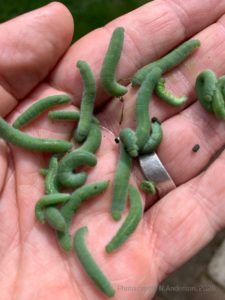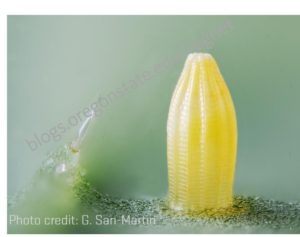
Imported Cabbageworm (Pieris rapae) (Lepidoptera: Pieridae)
Also known as the small cabbage white butterfly (adult), or greenworm (larvae).
Identification and Life Cycle Adult butterflies are white, and about 30-50mm. The front wing has a dark ‘corner’, plus black circular dots (males have 1 spot, females have 2). There are at least 2 broods, but continual development has been noted in California.
Small larvae are pale green with a yellow dorsal stripe (on their back). As larvae mature, they develop a fuzzy appearance and retain the yellow stripe, although it may appear broken in spots. Yellow markings also occur along the sides.
Pupae are ornate (see photo below), with keeled projections and orange coloring. One should become familiar with pupal ID because this is the overwintering stage.
Damage
Damage can be extensive, and appears similar to slug damage. Leaf margins are defoliated first, and if left unchecked, plants can be reduced to nothing but stems and midribs.
On older plants, tunneling into heads is common. This species produces a large amount of wet, greenish fecal pellets which can cause rejection of commercial cauliflower heads.
Monitoring
 Adults are not very active during cloudy or breezy days, and a commercial pheromone is not available. Because of this, monitoring for this species is difficult, especially in the PNW.
Adults are not very active during cloudy or breezy days, and a commercial pheromone is not available. Because of this, monitoring for this species is difficult, especially in the PNW.
The butterflies have a distinct, erratic flight which may help you see them in the landscape. They usually fly low above brassica fields or weedy borders (see video).
Do not spray for adult butterflies. If many adults are seen fluttering about, return in a few days and scout. Closely examine leaves for rocket-shaped eggs laid singly. Small larvae tend to prefer leaf undersides.
Consult the PNW Handbook for more information and current management recommendations.
- Female CWB butterfly (2 wing spots) and newly laid egg
- Larvae are velvety in appearance, and have small yellow dots along both sides. PHOTO CREDIT: Brkipto,2017 bamona.org
- Chrysalises are ornate and anchored to leaf tissue by a silk pad



